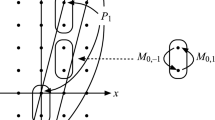Abstract
Chiral objects, viewed as distorted derivatives of achiral ones, may be represented by points in a configuration space that is spanned by a set of symmetry coordinates derived for the symmetry group of the achiral object of highest symmetry. We propose a measure (d) that quantifies the displacement of the representative point for a chiral object away from thenearest point representing an achiral object in such a multi-dimensional configuration space. If the symmetry coordinates are chosen so as to yield a similarity invariant measure, then the valuesd; obtained for a series ofi chiral objects can serve as a basis for comparing the degrees of chirality of these objects. The chirality of triangles inE 2 is studied by this method, and it is shown that the most chiral triangle in terms of this measure corresponds to one that is infinitely flat, and that may be approached but is never attained. This result is compared to others obtained previously for the same system by the use of different measures of chirality.
Similar content being viewed by others
References
WT. Kelvin,Baltimore Lectures on Molecular Dynamics and the Wave Theory of Light (C.J. Clay, London, 1941 p. 619.
A.I. Kitaigorodskii,Organic Chemical Crystallography (Consultants Bureau, New York, 1961), p. 230.
G. Gilat and L.S. Schulman, Chem. Phys. Lett. 121 (1985)13;
G. Gilat, J. Phys. A22 (1989)L545;
G. Gilat, Foundat. Phys. Lett. 3 (1990)189.
V.E. Kuzmin and I.B. Stelmakh, Zh. Strukt. Khim. 28 (1987)45, 50;
V.E. Kuzmin and I.B. Stelmakh, Dokl. Akad. Nauk SSSR 307 (1989)150;
L.A. Kutulya, V.E. Kuzmin, I.B. Stelmakh, I.B. Nemchenok and T.V. Khandrimailova, Zh. Obshch. Khim. 60 (1990)737.
F.M. Jaeger,Lectures on the Principle of Symmetry and Its Applications in All Natural Sciences (Elsevier, Amsterdam, 1917), ch. 2.
K. Mislow and J. Siegel, J. Amer. Chem. Soc. 106 (1984)3319;
[6](b) See also: E.A. Halevi, J. Chem. Res. (S)(1985)206; S. Fujita, J. Amer. Chem. Soc. 112(1990)3390.
P. Murray-Rust, H.B. Bürgi and J.D. Dunitz, Acta Cryst. B34 (1978)1787.
P. Murray-Rust, H.B. Bürgi and J.D. Dunitz, Acta Cryst. A35 (1979)703.
R.S. McDowell, J, Mol. Spectrosc. 17 (1965)365.
A.B. Buda and K. Mislow, J. Mol. Struct. (THEOCHEM), in press.
J.P. Glusker and K.N. Trueblood,Crystal Structure Analysis: A Primer, 2nd ed. (Oxford University Prey, New York, 1985), 225.
A.B. Buda and K. Mislow, Elem. Math., in press.
A.B. Buda, T.P.E. Auf der Heyde and K. Mislow, J. Math. Chem., preceding paper.
F.A. Cotton,Chemical Applications of Group Theory, 2nd ed. (Whey -Interscience, New York, 1971).
S.F.A. Kettle,Symmetry and Structure Whey, New York, 1985).
Author information
Authors and Affiliations
Additional information
On leave from the Department of Chemistry, University of the Western Cape, Bellville 7530, South Africa.
Rights and permissions
About this article
Cite this article
Auf der heyde, T.P.E., Buda, A.B. & Mislow, K. Desymmetrization and degree of chirality. J Math Chem 6, 255–265 (1991). https://doi.org/10.1007/BF01192584
Received:
Issue Date:
DOI: https://doi.org/10.1007/BF01192584




